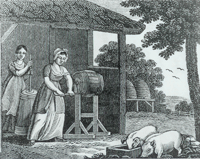 We often think of the dairymaid charmingly churning butter in a picturesque setting (image below) - plunging the dasher into the churn or turning the handle of a barrel churn; but in 1850s Holland, other devices were created to churn 200 quarts of cream at a time. The Treadle Lever or standing see saw; and pulling down large levers...
We often think of the dairymaid charmingly churning butter in a picturesque setting (image below) - plunging the dasher into the churn or turning the handle of a barrel churn; but in 1850s Holland, other devices were created to churn 200 quarts of cream at a time. The Treadle Lever or standing see saw; and pulling down large levers...
From an 1859 book: "In North Holland and West Friesland, also, sizes are found in which one
hundred and fifty to two hundred quarts of cream can be churned. The churns
have each a strong cover at the top, which fits into their rim about the
thickness of the hand, with a hole in the middle for the dasher.
The churning is performed either by the hand motion of the dasher, as
in all small dairies, and in the smallest churns, or by man-power with the help
of certain mechanical contrivances. The means for effecting this are different,
and so the churns have different names.
MOVING THE DASHER.
In many dairies, for instance, they have a lever connected with the
dasher; in other places they use a flexible pole, fixed into the ceiling above,
for facilitating the motion of the dasher, or put a lever in motion with the
feet, which raises and sinks the dasher. There are also complicated artificial
butter-machines and butter-mills, which are named after the inventor, the
manufacturer, or the motive power. The most known and widely used are the
turning-mills, the wheel-mills, and the clock-work mills; as the Hand Butter-Mill
of Valk, Fiirst's churn, etc.
Lever Churn
The Lever Churn is very commonly used in South Holland, Fig. 101. The
churn itself is barrel-form, as already described, and the dasher is put in
motion by a lever. The upper end is pierced with holes, through which runs an
iron pin. In a beam of the ceiling two joists are firmly fixed, about a foot
and five inches long and four inches square, and several inches apart. The
longer arm of the lever is four feet and seven inches; the shorter, three feet
and six inches. The churn stands under the short arm of the lever, where the
dasher is fixed. By drawing the longer arm of the lever towards him, the
operator presses the dasher down through the cream. This mode is far less
wearisome than the hand-churn, because by the lever, with less expense of
power, a far greater agitation is produced. A weight is sometimes attached to
the longer arm, by which the power required is still further reduced.
Churning With an Elastic Rod.
The old-fashioned churn is set in
motion by the aid of another kind of power, as seen in Fig. 102. A long, tough,
flexible stick is fastened into the cross-beam in the ceiling, so that its
larger end is held firm by two iron clasps. The elasticity of the rod is such
that, when the smaller end is drawn down by hand, which, at the same time,
moves the dasher, it rebounds, and thus saves considerable expenditure of
power.
Churning with the Treadle Lever.
In many places the churn is put
in
motion by the feet, as in Fig. 103, where several levers are united to produce
the upward and downward motion of the dasher. The longer arm of the lever is
connected with the churn, and the shorter is set in motion by a foot-board. The
foot-board lies on a roller, with its longer part attached to the lever; and by
throwing the weight of the body upon this part the shorter arm of the lever is
drawn down, and the longer, attached to the churn dasher, is raised. The mode
of operation is so plainly seen in the cut as to need no explanation."
Milch Cows and Dairy Farming…by Charles Louis Flint, NY: 1859
©2016 Patricia Bixler Reber
Researching Food History HOME






No comments:
Post a Comment